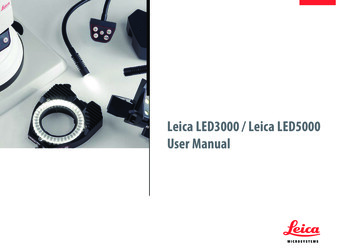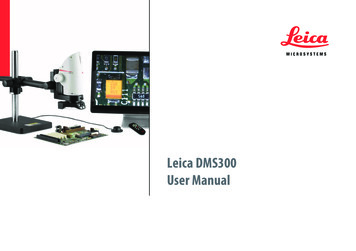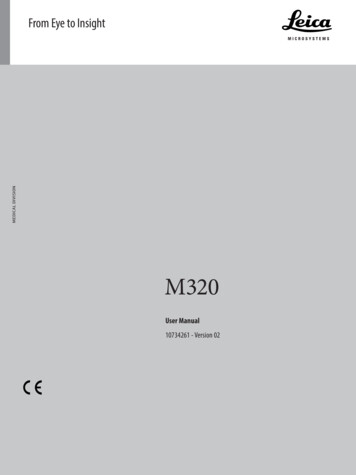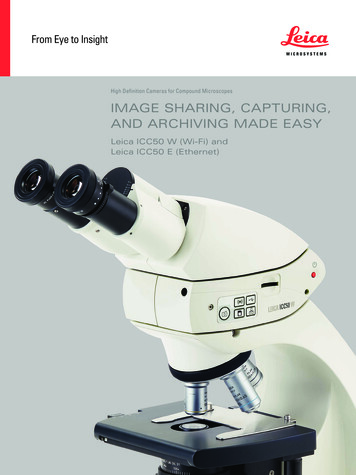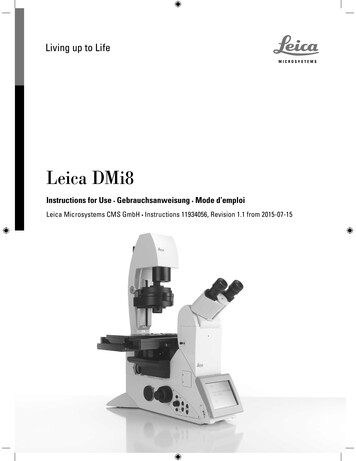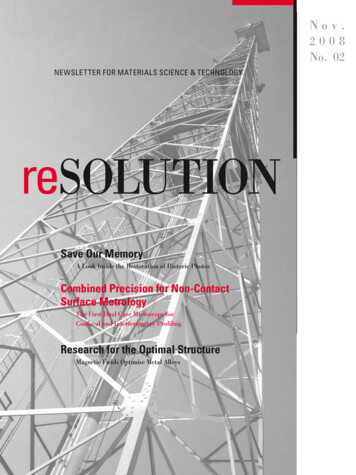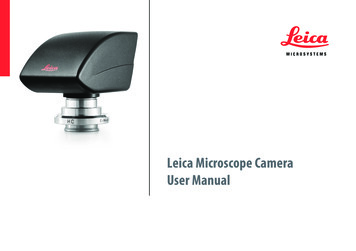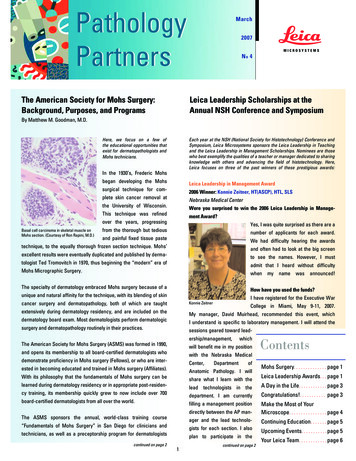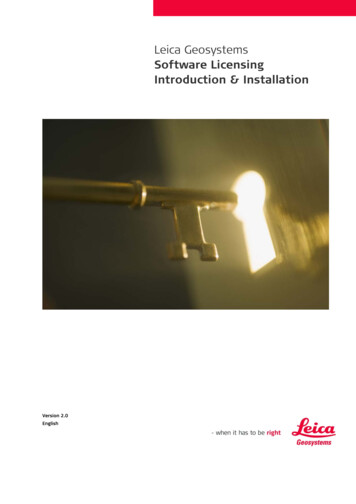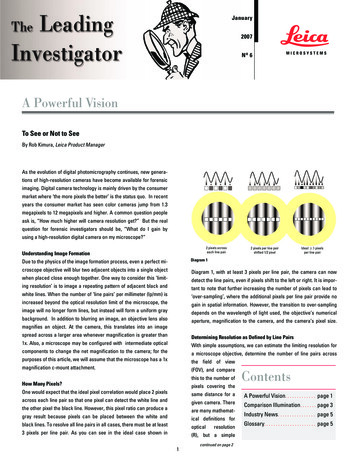
Transcription
January2007No 6A Powerful VisionTo See or Not to SeeBy Rob Kimura, Leica Product ManagerAs the evolution of digital photomicrography continues, new generations of high-resolution cameras have become available for forensicimaging. Digital camera technology is mainly driven by the consumermarket where ‘the more pixels the better’ is the status quo. In recentyears the consumer market has seen color cameras jump from 1.3megapixels to 12 megapixels and higher. A common question peopleask is, “How much higher will camera resolution get?” But the realquestion for forensic investigators should be, “What do I gain byusing a high-resolution digital camera on my microscope?”2 pixels acrosseach line pairUnderstanding Image Formation2 pixels per line pairshifted 1/2 pixelIdeal: 3 pixelsper line pairDiagram 1Due to the physics of the image formation process, even a perfect microscope objective will blur two adjacent objects into a single objectDiagram 1, with at least 3 pixels per line pair, the camera can nowwhen placed close enough together. One way to consider this ‘limit-detect the line pairs, even if pixels shift to the left or right. It is impor-ing resolution’ is to image a repeating pattern of adjacent black andtant to note that further increasing the number of pixels can lead towhite lines. When the number of ‘line pairs’ per millimeter (lp/mm) is‘over-sampling’, where the additional pixels per line pair provide noincreased beyond the optical resolution limit of the microscope, thegain in spatial information. However, the transition to over-samplingimage will no longer form lines, but instead will form a uniform graydepends on the wavelength of light used, the objective’s numericalbackground. In addition to blurring an image, an objective lens alsoaperture, magnification to the camera, and the camera’s pixel size.magnifies an object. At the camera, this translates into an imagespread across a larger area whenever magnification is greater thanDetermining Resolution as Defined by Line Pairs1x. Also, a microscope may be configured with intermediate opticalWith simple assumptions, we can estimate the limiting resolution forcomponents to change the net magnification to the camera; for thea microscope objective, determine the number of line pairs acrosspurposes of this article, we will assume that the microscope has a 1xthe field of viewmagnification c-mount attachment.(FOV), and comparethis to the number ofContentsHow Many Pixels?pixels covering theOne would expect that the ideal pixel correlation would place 2 pixelssame distance for aacross each line pair so that one pixel can detect the white line andA Powerful Vision. . . . . . . . . . . . . page 1given camera. Therethe other pixel the black line. However, this pixel ratio can produce aComparison Illumination. . . . . . . page 3are many mathemat-gray result because pixels can be placed between the white andical definitions forblack lines. To resolve all line pairs in all cases, there must be at leastoptical3 pixels per line pair. As you can see in the ideal case shown in(R), but a simpleresolutioncontinued on page 21Industry News. . . . . . . . . . . . . . . . page 5Glossary. . . . . . . . . . . . . . . . . . . . . . page 5
A Powerful Visioncontinued from page 1approximation is:Color CameraλAperture (NA) LensR λ / 2 NumericalR A pixel in a color (Bayer Matrix) camera performs two functions,of the light in nanometers (nm)where λ is the wavelength2(NA)where λ is the wavelength of the light in nanometers (nm)spatial sampling of the image and measuring the intensity for aThis relationship indicates that when using a high NA lens and whiteConsequently, it takes more pixels (approximately 25% more per linelight illumination, the smallest resolvable distance is about 300nm orpair) to obtain the same resolution as a monochrome camera.0.3µm. In terms of line pairs per mm at a mid wavelength of the visibleRequired color camera resolution (4 pixels/lp) 23 megapixelsspecific position of the spectrum, e.g., red, green, and blue.light spectrum, green 550nm:Optical Resolution (lp/mm) NA x 3000Optical Resolution (lp/mm) NA x 3000To calculate the number of line pairs required to cover the objective’sFOV, calculate the area visible through the lens by dividing the FOV ofyour microscope (let’s assume 22mm) by the magnification factor.A 5x objective allows you to observe an area of 4.4mm φ22mm FOV 4.4mm5A 50x objective allows you to observe an area ofonly less than 0.5mm φ22mm FOV 0.44mm50So how many line pairs can be observed with a 5x objective? Simplymultiply the visible area by the optical resolution to calculate the FOV.But please note that there is one caveat in calculating FOV. While amicroscope objective forms a circular image, a camera sensor istypically square or rectangular. If the FOV for the microscope is22mm, then the FOV of the sensors reduced by the square root of 2.Diagram 2Example: Using a 5x objective with a .15 NA and a 22mm FOV4.4 2In the above example, the lens is capable of better resolution 3.1mmthan today’s high-resolution cameras can capture.At higher magnification, a lower megapixel camera is required.Achievable Optical Resolution 0.15 x 3000 450 lp/mmLets take a 50x, 0.85 NA objective with a square FOV as an example:Line pairs covering camera sensor 3.1mm x 450 lp/mm 1400 lp(22mm50x ) 0.31mmMonochrome Camera 2The monochrome camera presents an ideal case as every pixel contributes equally to the resolution. The number of pixels required tocapture every bit of spatial information coming from the objective is:Achievable Optical Resolution 0.85 NA x 3000 2550 lp/mmPixels across line pair 1400 lp x 3 pixels/lp 4200 pixelsLine pairs covering the camera’s sensor Camera resolution is specified in terms of the total number of pixels,0.31mm x 2550 lp/mm 790 lpso assuming a rectangular 4:3 format, the number of pixels Note thatas opticalmagnificationincreases,the(3 numberof pixels 4.2megapixelsneeded to match the optical resolution decreases.for ideal digital image quality is:4200 pixels x 3150 pixels 13 megapixelsRequired color camera resolution (4 pixels/lp) 7.5 megapixels2continued on page 3
Comparison IlluminationA Powerful Visioncontinued from page 2Achieving the Best Illumination for YourComparison Microscopeby Wayne Buttermore, Leica Marketing Manager, Forensic MicroscopyDo I Need a High-Resolution Digital Camera?One of the biggest challenges in comparison microscopy is balancingNow let’s get back to our original question. High-resolution, 8-pluscolor and intensity of the light sources between the two microscopes.megapixel cameras provide a resolution benefit at low magnification.Unlike reflected light applications the transmitted light comparisonBut as magnification increases, they provide less of an advantage.microscope has many more variables, that affect both illuminationWhat is optimum depends on what kind of imaging you are doing.intensity and color balance.More pixels will increase the size of the image file. As the number ofpixels increases, each pixel is typically smaller, which results inThe setup of a compound microscope for diffraction-limited examina-reduced dynamic range and light sensitivity.tion of trace evidence is best achieved by setting up Koehler illumination. Experienced microscopists can reproducibly establish theGoing beyond 8 megapixels makes sense for very low magnificationssettings for the field and aperture diaphragms on an individualtypically used in comparison forensic macroscopy, if the entiremicroscope to achieve the best resolution and contrast for a sample.available FOV is used. But even with fewer pixels, adjusting theHowever, when a second microscope is added to the system, match-magnification to the camera with an intermediate optic accessorying the setup becomes far more complex.such as a 1x magnification c-mount, you can match the camera tothe microscope’s resolution across a limited field of view.First, let’s look at the different illumination types that are used forcomparison microscopy: 1. Two separate lamphouses controlled by separate powersupplies: This was a common illumination setup found on oldercomparison microscopes from American Optical, Leitz,and Leeds. Pre 19802. Two separate lamphouses controlled by separate powersupplies with continuous variable filter systems in theillumination path (Leica Variolux ): Leitz and Leica used thisconfiguration for many years on comparison systems usingthe Laborlux, Dialux, Dialux 20, DM R, and DM4000 microscopeplatforms. 1980’s to present3. Randomized bifurcated fiber optic light guides from a singlecold light source (150W or 250W): Adapted to the illuminationpath in place of standard halogen light bulb sources.Mid 1980’s to presentA microscope is designed with many optical elements apart from theillumination source that affect color. As light travels through themicroscope, it passes through a collecting lens, diffuser, fielddiaphragm, glass cover for the light exit port, filter holder for coloredglass or interference filters, aperture diaphragm, condenser element,slide, mounting media with sample, coverglass and finally to theobjective, eyetube lens, and eyepieces. Each of these componentscan be responsible for changing the light path, intensity, and color ofthe light passing through the optical system.In the design and manufacture of modern comparison microscopes,care is taken to select matching optical components to reduce thesecontinued on page 43
Comparison Illuminationcontinued from page 3influences by decreasing manufacturing tolerances and ensuringadjustable color to the illumination path on each microscope. Withthat components originate from the same production lot. Ideally,practice, it provides a perfect match of color and intensity duringthis leaves only lamp intensity, condenser height position, andside-by-side examinations.field and aperture diaphragm settings as variables to contend with.In systems having a Leica Variolux adjustable filter device, theProcedure for Adjusting Variolux 1. When starting, be sure to re-process of balancing illumination and color is simplified.move any colored filters fromHow do I ensure balanced intensity and color?the optical path.Initially it is critical to set up the two light sources as uniformly asthis means neutralizing thepossible:Variolux by turning the filters to1. Prepare two identical slides with slides and coverglass fromEssentiallythe open position. It is easiestthe same box. Place a slide on each microscope stage.to accomplish this by observing2. Place the comparison bridge in the side-by-side image mode.the field of view and turning3. Select the 10x objective for each microscope.each color filter control. If col-Color filter wheela. When using a two-lamphouse system, adjust lamp intensityor is added while turning theso the voltage is the same for both sides. Adjust the collectorknob, reverse direction until it reaches the stop position. Thislens for each lamphouse so that intensity and homogeneityneeds to be completed on both microscopes. If any colors wereof the field of view is as uniform as possible.introduced by the Variolux during initial illumination setup asb. In microscopes with bifurcated fiber optic systems, adjustdescribed above, repeat the illumination setup.lamp intensity to a comfortable level for the objective in use.If intensity or homogeneity is not consistent, rotate the fiber2. Carefully examine the color of the light on each microscope side.bundle at its interface with the microscope. Then secure itKeep in mind the complimentary color. If a yellow tint is viewed onin place. Intensity can be influenced by moving the fiberone side, the addition of an equal amount of blue would beoptic guide forward or backward in the mount.required to offset the effect. If the color match gets worse as theprocess continues, start over.4. Be sure to remove any colored glass filters, polarizers orpolarization compensators from the light path.5. Remove the first two slides from step 1, and place two new3. When any component in the optical path is changed, such as theslides, each having a sample and coverglass, on the stagesample, objective or aperture setting, you may need to readjust theof each of the microscopes.Variolux.6. Establish Koehler illumination bysetting the condenser height,Balancing illumination intensity and color takes practice. It is muchcentering the field diaphragm, andeasier to set up a system for visual examination. A camera system,adjusting the aperture diaphragm towhether 35mm or digital, is far more sensitive to color and densitydifferences than the human eye, so fine tuning the camera may stillmatch the objective in use. (Leicausers can refer to the Leica DM RFigure 49: establish Koehlerilluminationbe necessary.user manual, Figure 49.) DiscussionNext issue: Achieving the best illumination for your digital cameraof Koehler illumination is outside the scope of this article. In microscopes with a bifurcated illumination system, these stepsshould be all that is required to obtain visually balanced light intensityand color.Two Lamphouse Systems:Systems having two light sources and Variolux continuous illumination control may require further adjustment. A Variolux contains threeindependent filter controls for continuous introduction of red, greenor blue filters with increasing gradients. This introduces infinitely4
Industry NewsGlossaryThe AAFS (American Academy of Forensic Sciences) will holdKoehler Illumination: A characteristic feature of the light pathits 59th Annual Scientific Meeting on February 19-24, 2007 at theprovided by all high-quality microscopes is the consistent imaging ofHenry B. Gonzalez Convention Center in San Antonio, Texas.the “luminous spot on the light source” and the “illuminated field”The Academy's annual scientific meeting presents over 500 scientificthrough all imaging stages of the microscope, from the light source topapers, breakfast seminars, workshops, and other special events.the final image. These conditions are met when the field and apertureThe AAFS represents a wide range of forensic specialties.diaphragm, positions in the microscope light path are conjugatedMore information: www.aafs.orgto the object plane and to the rear focal plane of the objective,respectively.The 38th annual AFTE Training Seminar will take place at the HyattRegency, San Francisco, California on May 27-June 1, 2007. AFTEWhite Point: A white point is one of a number of reference illumi-welcomes everyone to this beautiful city and to what promises to benants used in Colorimetry, which serve to define the color "white".a fantastic training conference. The host committee comprises notDepending on the application, different definitions of white areonly the San Francisco Police Department – Firearms and Toolmarkneeded to give acceptable results.Unit, but also firearms examiners from various agencies all overNorthern California such as Contra Costa County Sheriff’s Office,Color Temperature: Visible light is commonly described by its colorSanta Clara County, Fresno DOJ, Sacramento DOJ, BATFE-Walnuttemperature. A traditional incandescent light source's color tempera-Creek, Sacramento County, and Oakland PD.ture is determined by comparing its hue with a theoretical, heated,More information: www.afte.orgblack-body radiator. The lamp's color temperature is the temperature, measured in kelvins, at which the heated black-body radiatorThe 2007 ASQDE Meeting will be held on August 11-16, 2007 at thematches the hue of the lamp. Color temperature is sometimes usedBoulder, CO Millennium Harvest House. More information will beloosely to mean "white balance" or “white point”.provided as it becomes available: www.asqde.orgLine Pairs Resolution: Line “pairs” are often used to measureThe 2007 Annual Meeting of the Southern Association of Forensicresolution instead of lines. A line pair is a pair of adjacent dark andScientists will be on September 9-14, 2007 in Atlanta. A full programlight lines; while a line counts both dark lines and light lines. A resolu-is planned including Advanced Structure Elucidation (DI), LC Tandemtion of 5 line pairs per mm means 5 dark lines alternating with 5 lightMS use in Post-mortem Cases, and Statistics in DNA Analysis.lines, or 10 lines per mm.More information: www.southernforensic.org Editorial StaffEditor-in-Chief:Managing Editors:Graphic Design:Contributing Editor:Molly LundbergPam Jandura, Wayne ButtermoreM.N. KennedyRob KimuraNote: We are interested in your comments and thoughts about the newsletter. Pleasefeel free to email your comments to molly.lundberg@leica-microsystems.com.5
comparison microscopes from American Optical, Leitz, and Leeds. Pre 1980 2. Two separate lamphouses controlled by separate power supplies with continuous variable filter systems in the illumination path (Leica Variolux ): Leitz and Leica used this configuration for many years on comparison systems using
